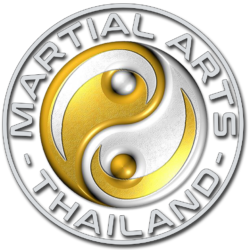Bruce Lee’s JKD, the ”Original Mixed Martial Art”?
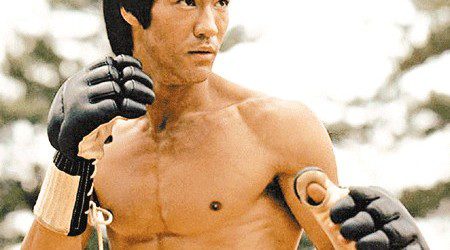
(By Mark Stewart)
Although the Gracie family of Brazil successfully transplanted BJJ and Vale Tudo to the world via the UFC many in the greater martial arts community also credit Bruce Lee’s philosophy of “not being bound” by any particular style of martial art, as the seed of today’s Mixed Martial Arts Movement. MMA Superstars, Frank Shamrock and Randy Couture consider Bruce as the “Father” of MMA and Dana White (President of the UFC) has crowned Bruce Lee as the inspiration and original martial artist in mainstream America, who trained like an MMA fighter and taught the teachings of MMA, way before the UFC was even thought of.
Bruce Lee
 In 1959 an 18 year old Bruce Lee moved from Hong Kong to the U.S. and eventually attended the University of Seattle, where he majored in philosophy. There he began the journey of creating his own personal martial art. Around 1967 he named his method Jeet Kune Do (JKD) or “way of the intercepting fist”. In 1970 he returned to Hong Kong to make movies and unexpectedly passed away in 1973. Posthumously Lee became a superstar worldwide, revolutionized the world of modern martial arts and continues to inspire martial artists today.
In 1959 an 18 year old Bruce Lee moved from Hong Kong to the U.S. and eventually attended the University of Seattle, where he majored in philosophy. There he began the journey of creating his own personal martial art. Around 1967 he named his method Jeet Kune Do (JKD) or “way of the intercepting fist”. In 1970 he returned to Hong Kong to make movies and unexpectedly passed away in 1973. Posthumously Lee became a superstar worldwide, revolutionized the world of modern martial arts and continues to inspire martial artists today.
Research and Development
While in Hong Kong Lee studied “Wing Chun”, a style of Chinese Gung Fu. According to many, early on Lee’s goal was to be the best wing chun man around. 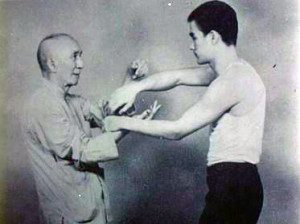 However, Lee was already researching different styles of MA and was highly influenced by other Chinese Styles, Western Boxing and Western Fencing. When Lee moved to the U.S. he also began to research Judo, Jiu Jitsu and Wrestling. Lee’s research entailed both book/film research as well as hands on experience. This “hands on” experience was usually accomplished through exchanging his knowledge of Gung Fu with practitioners of a different styles willing to compare notes and experiment outside of their system.
However, Lee was already researching different styles of MA and was highly influenced by other Chinese Styles, Western Boxing and Western Fencing. When Lee moved to the U.S. he also began to research Judo, Jiu Jitsu and Wrestling. Lee’s research entailed both book/film research as well as hands on experience. This “hands on” experience was usually accomplished through exchanging his knowledge of Gung Fu with practitioners of a different styles willing to compare notes and experiment outside of their system.
Reality
Bruce Lee felt that a real fight was unpredictable and that most classical styles emphasized “dead patterns” instead of live and spontaneous training. Lee believed that combative sports such as boxing and judo were practiced more realistically than most classical systems. Why? They made real impact and they practiced live training and not dead patterns. Lee also came to the conclusion the MA was Universal and that “unless there is a being with more than two arms and two legs, that there is only one style of fighting, the human style.” So, Lee conceptualized martial art as a whole and embarked upon a scientific course. Not one that blended styles but one that was born of the idea of non-style, geometry and physics. One as he described as “simple, direct and non-classical” (functional). In a sense Lee’s JKD is a martial art with no rules that is practiced like a combative sport with real impact (full contact) and live training. This approach was very revolutionary during the time of its creation and is still quite rare in contrast to the many classical martial arts schools of today.
Philosophy
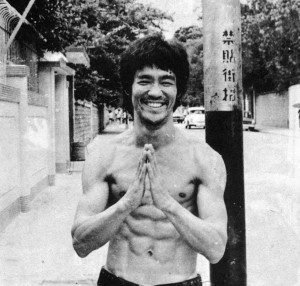 At the same time that Lee was creating his martial art he was also very much into philosophy. One source of philosophy was Zen Buddhism. One of the primary tenants of Buddhism is detachment or more clearly, non-attachment. The tenant of non-attachment can be a paradox for most. However for Bruce Lee it may have been the perfect vehicle of understanding (enlightenment) that he needed to create his Jeet Kune Do. While non-attachment is a mental state, non-engagement is its physical counterpart. In the sense of fighting attachment or engagement imputes struggle. So with non-engagement through the use of physical science, our goal is non-struggle or to fight with the least amount of struggle. Actually this theory is nothing new and can be found in styles such as aikido, tai chi and jiu jitsu/judo.
At the same time that Lee was creating his martial art he was also very much into philosophy. One source of philosophy was Zen Buddhism. One of the primary tenants of Buddhism is detachment or more clearly, non-attachment. The tenant of non-attachment can be a paradox for most. However for Bruce Lee it may have been the perfect vehicle of understanding (enlightenment) that he needed to create his Jeet Kune Do. While non-attachment is a mental state, non-engagement is its physical counterpart. In the sense of fighting attachment or engagement imputes struggle. So with non-engagement through the use of physical science, our goal is non-struggle or to fight with the least amount of struggle. Actually this theory is nothing new and can be found in styles such as aikido, tai chi and jiu jitsu/judo.
Simplicity
JKD however is the way of the intercepting fist and seeks to end the fight as quickly as possible through striking. In JKD engagement is any touch reference other than the strike itself. So ours is a 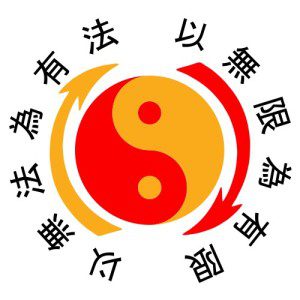 very aggressive form of non-engagement which is a paradox to most but the “true vehicle” of understanding and expressing JKD. JKD primarily emphasizes stepping and evading to strike (without prior touch) and secondarily deflecting, trapping and grappling to strike (with prior touch). For decades following Bruce Lee’s death JKD was promoted as the concept of cross training and doing your own thing. This view of JKD gave birth to the creation of many “freestyles” and “hybrids” throughout the world. Not a bad thing but not JKD. Bruce Lee clearly researched the totality of martial art, which includes striking and grappling both standing up and on the ground. But because Lee found that the “height of cultivation lead to simplicity” and that non-engagement is the height of that simplicity, JKD is a scientific vehicle of expressing simplicity in the chaos of fighting. Lee was also an actor and had the ability to use the screen to get some of his ideas across, like in the opening scene of “Enter the Dragon”, with Samo Hung, Lee clearly illustrates his interest in the idea of the “complete fighter”. (kicking, punching, take downs and submissions) But what does complete mean? And complete at what cost? These are important questions for each individual martial artist seeking totality.
very aggressive form of non-engagement which is a paradox to most but the “true vehicle” of understanding and expressing JKD. JKD primarily emphasizes stepping and evading to strike (without prior touch) and secondarily deflecting, trapping and grappling to strike (with prior touch). For decades following Bruce Lee’s death JKD was promoted as the concept of cross training and doing your own thing. This view of JKD gave birth to the creation of many “freestyles” and “hybrids” throughout the world. Not a bad thing but not JKD. Bruce Lee clearly researched the totality of martial art, which includes striking and grappling both standing up and on the ground. But because Lee found that the “height of cultivation lead to simplicity” and that non-engagement is the height of that simplicity, JKD is a scientific vehicle of expressing simplicity in the chaos of fighting. Lee was also an actor and had the ability to use the screen to get some of his ideas across, like in the opening scene of “Enter the Dragon”, with Samo Hung, Lee clearly illustrates his interest in the idea of the “complete fighter”. (kicking, punching, take downs and submissions) But what does complete mean? And complete at what cost? These are important questions for each individual martial artist seeking totality.
Mixed Martial Arts
The distinction between fighting and any combative sport is that it has rules and a real fight does not. However in a civilized world, a fighter with morals needs a place to play – seriously. Mixed Martial Arts is the perfect arena for such serious play. Is MMA the evolution of combative sports that Lee envisioned through his martial art so many years ago? “Partially so”. Lee directly and indirectly, during and after his life affected so many martial artists.
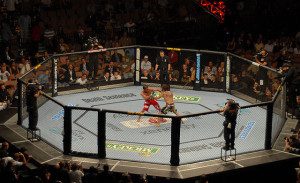 Has MMA evolved to Lee’s simple and pragmatic approach? As MMA has evolved as a sport so has its strategy and it’s players. In the beginning, in events such as the UFC, Brazilian Jiu Jitsu Players and Wrestlers dominated the arena against classical strikers who never trained to (en) counter grappling. Today’s MMA athletes are mostly “well rounded” fighters in the realms of striking and grappling both standing up and on the ground. However the majority of athletes do not struggle as much as their founding fathers did. Controlling distance to strike and avoid take downs, seeking dominant position to strike and getting up off the ground quickly have become the strategy of the new fighters. Why is this true? Because “the height of cultivation leads to simplicity”. Why struggle when you don’t have to?
Has MMA evolved to Lee’s simple and pragmatic approach? As MMA has evolved as a sport so has its strategy and it’s players. In the beginning, in events such as the UFC, Brazilian Jiu Jitsu Players and Wrestlers dominated the arena against classical strikers who never trained to (en) counter grappling. Today’s MMA athletes are mostly “well rounded” fighters in the realms of striking and grappling both standing up and on the ground. However the majority of athletes do not struggle as much as their founding fathers did. Controlling distance to strike and avoid take downs, seeking dominant position to strike and getting up off the ground quickly have become the strategy of the new fighters. Why is this true? Because “the height of cultivation leads to simplicity”. Why struggle when you don’t have to?
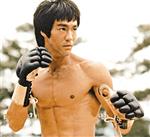 Real impact and live training are the hallmarks of JKD and may be applied in the arenas of Self Defense as well as Combative Sports. Competition is a great arena to test yourself and is much safer than the street. And as you win and lose remember that you are your own best friend as well as your own worst enemy and that your most apparent strength is also your most apparent weakness. These are the tenants of yin/yang that Lee chose so well to symbolize his martial art both physically and philosophically.
Real impact and live training are the hallmarks of JKD and may be applied in the arenas of Self Defense as well as Combative Sports. Competition is a great arena to test yourself and is much safer than the street. And as you win and lose remember that you are your own best friend as well as your own worst enemy and that your most apparent strength is also your most apparent weakness. These are the tenants of yin/yang that Lee chose so well to symbolize his martial art both physically and philosophically.
MMA has come a long way and is here to stay. Whether ones “foundation” is striking or grappling, stand up or ground fighting, the plain and simple truth is that you need to be exposed to all possibilities. How you deal with them will be based upon the foundation you choose and a working knowledge of the rest.
(Article courtesy of Mark Edward Stewart www.brijkd.com)
Photo credits:
